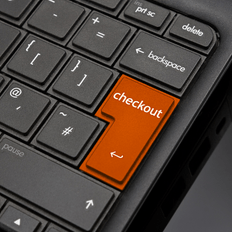Social media shopping, also known as social commerce; from the Facebook Marketplace to Instagram Shoppable tags, all the kids are doing it these days. Are you feeling social shopping peer pressure? Maybe you’re not sure if it works, or how it could go wrong, or if it’s the right choice for you. Good news: today, we’re going to give you a crash course, and you can decide if it’s right for your business.
Should I Do It?
The short answer is yes. Social commerce is the bright and shiny future of commerce, and while you won’t be an early adopter, you’ll still have the same opportunity to integrate this into your store and take advantage of all it has to offer. The sooner you start, the sooner you can connect with customers and experiment with different strategies to figure out what works.
However, there are a few cases when it won’t be the right choice for you.
Don’t do it if you’re not going to take it seriously. Scrolling through Facebook may be something your potential customers are doing while waiting for their latte, hanging out with friends, or lying in bed at night, but that doesn’t mean they don’t take it seriously. If you’re going to do it, invest the time and energy to do it well. If you don’t have the time and energy, invest in a company that will do it for you.
Don’t do it if you think it’s going to bring you passive income. You should be collecting data, tweaking your targeting, releasing new ad campaigns — the opposite of passive. This is as important as any other strategy you’re implementing, be it search engine optimization or dynamic pricing, and you’ll need to give it the same attention and care.
Don’t do it if you don’t have your store functioning smoothly and efficiently. If you’re still running into shipping issues, manufacturing problems, or anything in your existing processes, get those ironed out first. In other words, don’t scale up until you’re ready.
Is it the Same Thing as Social Media Marketing?
In a word, no. Social media marketing entails building up your brand on social media, creating a nice page that is consistent with your brand’s image, and running ads.
Social commerce is a way to leverage social media, and instead of promoting your brand in a marketing context, use it to actually sell your products within the site or app. You can use the aspects of social media to promote your company and increase awareness, but the social commerce part of it is an active and integrated part of the social media.
Where Should I Start?
Facebook:
this is the most widely used social media platform, and where a lot of businesses start out. You can build a Facebook page for your business where customers can like your page, interact with your posts, and shop directly from your store without ever leaving the site.
Of course, Facebook is also well-known for its sophisticated demographic targeting for ad campaigns, and these are well-worth investing in. Particularly for a mobile audience, finding your niche that will engage with your posts and be drawn in to visit your website is the best way to grow and reach a wider audience.
Pinterest:
buyable pins have been around for a while now, but the demographic there is a little more targeted. If your product demographic isn’t 18- to 35-year-old women, you likely won’t do well. It’s the 3rd most-popular platform among US adults, so it’s a pretty good network to establish a foothold.
Source: https://newsroom.pinterest.com/en/post/coming-soon-buyable-pins
While you may think that Pinterest doesn’t have great conversion rates, it actually has a higher average order size from referral traffic compared to Facebook, so it could be worth it.
Instagram:
the home of the Millennials — and also the best way to get some product shots from your customers. Instagram launched shoppable tags this year, so users can now see (and shop) up to five items per image.
Aside from shoppable tags, it’s a great way to develop a consistent brand image and theme in your profile, and promote yourself through popular hashtags. Companies will frequently run promotions for giveaways, where sharing a post is equivalent to one entry. And, of course, the classic ads between posts are also an option.
Snapchat:
Trying to keep up with Instagram’s social commerce strides, Snapchat has incorporated everything from augmented reality lenses to ads between snap stories. Again, not a great beginner option unless you have a very specific niche.
For beginners, Facebook is the legacy platform and Instagram is the rapidly gaining up-and-comer, so these are two great places to start. Magento Social is an easy way to integrate your existing Magento eCommerce store right into your Facebook Shop, where customers can browse and buy without ever leaving the page.
WooCommerce offers a great plugin for your WordPress site that will show a feed of photos from Instagram that have used your hashtag. This is an amazing way to feature customers and reward them for sharing.
For anything you do, make sure to enable social logins, sharing buttons, and provide social rewards — like a coupon for taking a social call to action. It should all be about making it as smooth of an experience as possible for your visitor.
Social logins mean that they don’t have to remember the login and password for your website; they can just log in through whatever social media outlet they choose. It’s more secure — people usually use the same logins and passwords, so if another website is compromised, their account won’t be compromised, because it will be authenticated through something like Facebook. It’s also just easier for them, which is your ultimate goal.
Enabling sharing buttons is, of course, a no-brainer. When a potential customer shares your products on their social media page, that is the best free advertisement you can get. And finally, you can reward the behaviors you want — sharing, engaging, tagging friends, etc. — by providing special coupon codes that can be applied automatically.
What Are the Advantages?
The biggest advantage is the genuine engagement you get with your audience. Social media enables companies to interact with customers in an unprecedented way, and it’s an interaction that feels personal and intimate. Instead of a static storefront where customers browse, read, and either purchase or don’t, social commerce allows them to like, comment, and share any content you put out — and you can respond.
Another huge advantage is — if you do it right — an increase in sales, average order, conversion rates, and basically any other metric you care about. When customers can shop directly within the site or app they’re already on, browsing and buying is a frictionless experience. It’s so easy to add products and check out that your viewers will do a lot more of it.
The third advantage: social media is a way to reach people you may never have reached before. While it’s true that the regular Internet has no geographic boundaries, social media will push your products out to people that may never have found your online store. You can even target a global audience to take advantage of this.
Another advantage is that you can harness the power of mobile! Mobile users are increasing in numbers, and people are spending a greater percentage of their time accessing the internet on their phones. Creating a social commerce platform that respects and caters to that audience will increase your sales and bring your brand to a greater audience.
Finally, say hello to a major social proof boost. When someone can see that their friends or family like your brand, have commented on your content, or even left a positive review, they are so much more likely to trust you and buy from you. You can take advantage of this by providing rewards for leaving positive reviews.
What Are the Disadvantages?
The first disadvantage is, funnily enough, the same as the first advantage: engagement. When your audience has the ability to interact with you however it wants, this doesn’t just mean liking your posts, tagging their friends, and leaving positive reviews. It can also mean airing their grievances in your comments section.
However, this provides you with a golden opportunity to turn it around.
This interpersonal engagement means that you can see their negative comment and use it as a chance to empathize, get to the root of the problem, and make it right for them — and it’s all visible right on your page.

The other main disadvantage is that it will cost you — time, effort, and money. Targeted ads cost money, setting up the shop costs time, and your whole strategy will involve a lot of effort and creativity to stay ahead of the competition. If you’re not sinking in those costs, you probably aren’t going to be effective.
You’ll also have to integrate it with your current processes so that it doesn’t have glitches or delays, or otherwise make your customers unhappy.
How Can I Do All of That?
If it seems like a lot, we understand — it can be overwhelming to think about the big picture. It should be the next big step for your business, but that doesn’t mean you’ll know exactly how to do it. When people talk about marketing for ecommerce, this is what they’re talking about. You can’t just set up a digital storefront and expect people to mosey on through. But if you put in the hard work and connect with your audience on social media, your efforts to find buyers on Facebook, Pinterest and elsewhere will ultimately pay off.
Talk to us about your business needs, contact us today!







